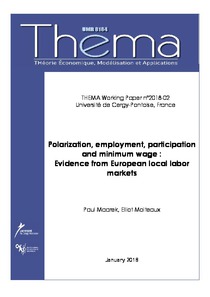Polarization, employment, participation and minimum wage: evidence from European local labor markets
"Since 1980, labor markets became increasingly polarized: occupations in the middle of the wage distribution (routine occupations) tend to disappear, and are replaced by low-wage occupations (man- ual occupations) and high-wage occupations (abstract occupations). In the US exible labor market,...
| Main Authors: | , |
|---|---|
| Institution: | ETUI-European Trade Union Institute |
| Format: | TEXT |
| Language: | English |
| Published: |
Cergy-Pontoise
2018
Université de Cergy-Pontoise |
| Subjects: | |
| Online Access: | https://www.labourline.org/KENTIKA-19397822124911150049-Polarization,-employment,-part.htm |
| Summary: | "Since 1980, labor markets became increasingly polarized: occupations in the middle of the wage distribution (routine occupations) tend to disappear, and are replaced by low-wage occupations (man- ual occupations) and high-wage occupations (abstract occupations). In the US exible labor market, the decrease of routine occupations has been compensated by massive creation of low-paying occupa- tions, and polarization only had a very limited impact on employment levels. This is not necessarily the case in rigid wage European countries in which the creation of such low-paying jobs is more dif- cult, given the institutional environment. We study the e ect of the reduction of the proportion of routine jobs on the employment rate and the participation rate, conditionally on the value of the min- imum wage, using local labor markets from the European Union Labor Force Survey on 8 countries which have a national minimum wage. Our OLS and IV estimates indicate that the disappearance of routine jobs has a negative impact on labor market outcomes in high-minimum wage countries due to an insucient creation of low-paid occupations. Impact on participation is positive for low minimum wage countries, as labor supply may increase in order to compensate the deterioration of labor market opportunities." |
|---|---|
| Physical Description: | 29 p. Digital |

